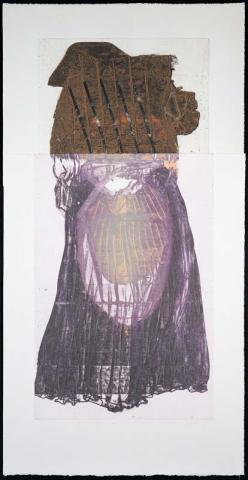KY, Marine; Pret-a-porter couturier/Paris, rue St-Germain-des-...
Marine Ky, born in Cambodia in 1966, lived in Macao and France during the 1970s and 1980s, before migrating to Australia in 1993. Ky studied Fine Arts in Paris at the Universite de Paris X and Ecole Superieure des Arts Appliques Duperre where she completed an honours degree in 1991. She undertook further study in printmaking at the Tasmanian School of Art in Hobart and completed her Masters of Fine Art in Printmaking in 2000 at the School of Art, University of Tasmania, under the guidance of master Australian printmaker, Ray Arnold. Ky has participated in solo and group exhibitions in Australia, Cambodia and Japan. In May 2001 she moved to Phnom-Penh.
The print Pret-a-porter couturier/Paris, rue St-Germain- des-Pres, 15h, en faisant de la leche-vitrine has a ghostly image of a dress in which the volume of fabric has been flattened to make a two-dimensional imprint. The dress belonged to Ky who is an avid collector of couturier fashion, a hobby formed as a young girl growing up in Paris (where her mother worked as a seamstress). There, as part of daily life, Ky assisted her mother after school by sewing sequins, beads, ribbons and silk in intricate patterns for the large fashion houses. In this literal impression of what was once an exquisite lace and tulle dress, Ky has drawn attention to the complex weaving of her own life within the title. In this interpretation of a 'ready to wear' collection, Ky reminds the viewer of her adolescent years. Her links to the textile industry have made a lasting impression and now continue to underpin how she constructs a sense of her self. The title includes the area where she lived in Paris, a renowned shopping district (rue St-Germain-des-Pres), the time (15h); and ends with the phrase 'en faisant de la leche-vitrine' (a colloquial term for window shopping). The literal translation of the French phrase is also the poetic metaphor, 'to make glass opaque'. Embedded here is double meaning; the process of glass gradually becoming opaque parallels the transparency of a young life gradually clouding with the complex and layered understanding of adult experience and perception, and in this instance Ky draws on her own cultural and geographical journey. The other, more obvious meaning is Ky's own real pleasure in window shopping, the fruits of which are reflected in her couturier collection of dresses.
Ky uses the dress as a vehicle to provide a rich and textured symbol and as a means of allowing a glimpse into her autobiography. On the top half of this print Ky uses the imprint of another cloth, layering the fine transparency of the silk bodice with a thicker and more formal pattern. This cloth belongs to Ky's family and was given to Ky by her parents as part of her inheritance. Ky's use of and interest in the dress and cloth in her practice as a printmaker becomes fascinating when observed as part of an older tradition that stems from Cambodia. In Cambodian culture, like many countries across South East Asia, cloth has traditionally been associated with strong symbolic value, a value embedded in the pattern, texture and weaving of a cloth. The handing down of family heirlooms includes a selection of cloths that have particular importance to each family, which have been woven or made by the women in the family before them. In Ky's case, her mother's skill and knowledge as a seamstress meant that the family were able to survive in Paris. In this instance the traditional ritual inheritance of cloth takes on an added layer of meaning. Global transference becomes curiously evident; Ky's mother helped her acquire her eclectic collection of couturier fashion, with both women understanding and appreciating its value on numerous levels.
This work is part of a series in which Ky uses her collection of dresses, cloths and inherited cloths to explore issues of surface, memory and history. As with the process of weaving cloth, this work considers the fertile terrain in which individual histories are the threads used to construct larger stories.
Connected objects
Metadata, copyright and sharing information
About this story
- Subject
